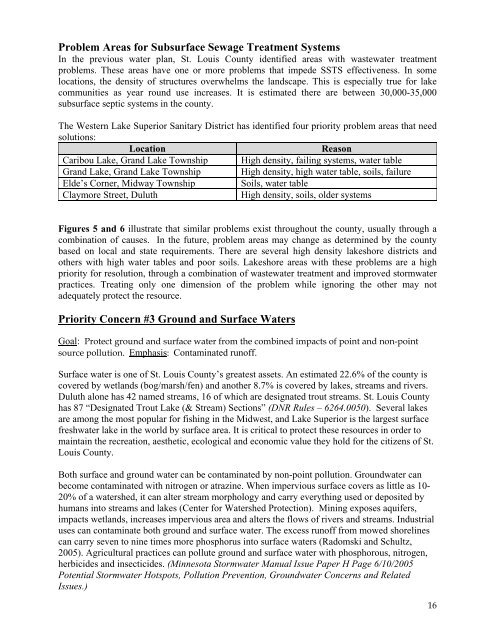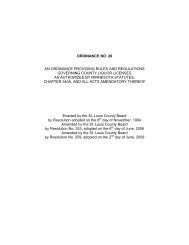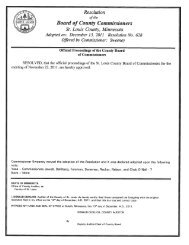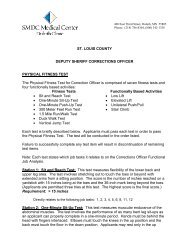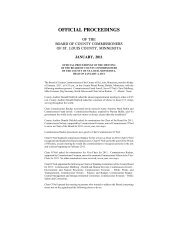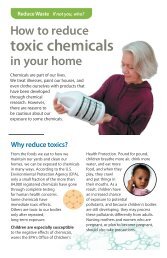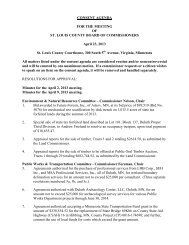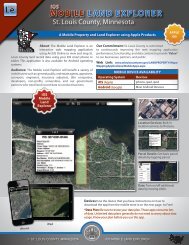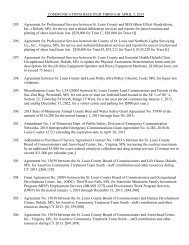Comprehensive Water Management Plan - St. Louis County
Comprehensive Water Management Plan - St. Louis County
Comprehensive Water Management Plan - St. Louis County
Create successful ePaper yourself
Turn your PDF publications into a flip-book with our unique Google optimized e-Paper software.
Problem Areas for Subsurface Sewage Treatment SystemsIn the previous water plan, <strong>St</strong>. <strong>Louis</strong> <strong>County</strong> identified areas with wastewater treatmentproblems. These areas have one or more problems that impede SSTS effectiveness. In somelocations, the density of structures overwhelms the landscape. This is especially true for lakecommunities as year round use increases. It is estimated there are between 30,000-35,000subsurface septic systems in the county.The Western Lake Superior Sanitary District has identified four priority problem areas that needsolutions:LocationReasonCaribou Lake, Grand Lake Township High density, failing systems, water tableGrand Lake, Grand Lake Township High density, high water table, soils, failureElde’s Corner, Midway Township Soils, water tableClaymore <strong>St</strong>reet, DuluthHigh density, soils, older systemsFigures 5 and 6 illustrate that similar problems exist throughout the county, usually through acombination of causes. In the future, problem areas may change as determined by the countybased on local and state requirements. There are several high density lakeshore districts andothers with high water tables and poor soils. Lakeshore areas with these problems are a highpriority for resolution, through a combination of wastewater treatment and improved stormwaterpractices. Treating only one dimension of the problem while ignoring the other may notadequately protect the resource.Priority Concern #3 Ground and Surface <strong>Water</strong>sGoal: Protect ground and surface water from the combined impacts of point and non-pointsource pollution. Emphasis: Contaminated runoff.Surface water is one of <strong>St</strong>. <strong>Louis</strong> <strong>County</strong>’s greatest assets. An estimated 22.6% of the county iscovered by wetlands (bog/marsh/fen) and another 8.7% is covered by lakes, streams and rivers.Duluth alone has 42 named streams, 16 of which are designated trout streams. <strong>St</strong>. <strong>Louis</strong> <strong>County</strong>has 87 “Designated Trout Lake (& <strong>St</strong>ream) Sections” (DNR Rules – 6264.0050). Several lakesare among the most popular for fishing in the Midwest, and Lake Superior is the largest surfacefreshwater lake in the world by surface area. It is critical to protect these resources in order tomaintain the recreation, aesthetic, ecological and economic value they hold for the citizens of <strong>St</strong>.<strong>Louis</strong> <strong>County</strong>.Both surface and ground water can be contaminated by non-point pollution. Groundwater canbecome contaminated with nitrogen or atrazine. When impervious surface covers as little as 10-20% of a watershed, it can alter stream morphology and carry everything used or deposited byhumans into streams and lakes (Center for <strong>Water</strong>shed Protection). Mining exposes aquifers,impacts wetlands, increases impervious area and alters the flows of rivers and streams. Industrialuses can contaminate both ground and surface water. The excess runoff from mowed shorelinescan carry seven to nine times more phosphorus into surface waters (Radomski and Schultz,2005). Agricultural practices can pollute ground and surface water with phosphorous, nitrogen,herbicides and insecticides. (Minnesota <strong>St</strong>ormwater Manual Issue Paper H Page 6/10/2005Potential <strong>St</strong>ormwater Hotspots, Pollution Prevention, Groundwater Concerns and RelatedIssues.)16


